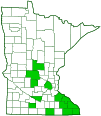large-fruited black snakeroot
(Sanicula trifoliata)
Conservation • Description • Habitat • Ecology • Use • Distribution • Taxonomy
Conservation Status |
|
|||||||
| IUCN Red List | not listed |
|||||||
| NatureServe | N4 - Apparently Secure S3 - Vulnerable |
|||||||
| Minnesota | Special Concern |
|||||||
Description |
||
Basal and lower stem leaves are palmately divided into 3 leaflets. The lateral leaflets are sometimes deeply cut making the leaf appear to have 5 leaflets — “3 looks like 3 (or 5)”. The flowers are white. There are 4 to 11 flowers, usually 7 or fewer, in each flower cluster. All umbellets include both male flowers and usually 3 perfect flowers. Perfect flowers are stalkless. Male flowers are on long stalks, rising above the perfect flowers. The sepals are longer than the petals. There are 1 to 8 stamens. They do not protrude beyond the calyx lobes. The styles are inconspicuous, shorter than the calyx. The seed capsules are ¼″ to 5 ⁄16″ long. The sepals in fruit converge, forming a beak as long or longer than the bristles. The styles in fruit are inconspicuous, shorter than the bristles. |
||
Height |
||
Up to 40″ |
||
Flower Color |
||
White |
||
Similar Species |
||
The number of leaflets on the basal and lower stem leaves of black snakeroots (Sanicula spp.) is an important identifying feature. However, the lateral leaflets are often deeply lobed, often to the base, appearing to be two separate leaflets. |
||
Habitat |
||
Moderately moist. Deciduous forests. Full shade. North-facing slopes. |
||
Ecology |
||
Flowering |
||
Mid-May to July |
||
Pests and Diseases |
||
|
||
Use |
||
|
||
Distribution |
||||
|
Sources |
|||
| 3/25/2023 | ||||
Nativity |
||||
Native |
||||
Occurrence |
||||
Rare |
||||
Taxonomy |
|||
| Kingdom | Plantae (Plants) | ||
| Division | Tracheophyta (Vascular Plants) | ||
| Subdivision | Spermatophytina (Seed Plants) | ||
| Class | Magnoliopsida (Dicots) | ||
Order |
Apiales (Carrots, Ivies, and Allies) | ||
| Suborder | Apiineae | ||
Family |
Apiaceae (carrot) | ||
| Subfamily | Saniculoideae | ||
| Tribe | Saniculeae | ||
Genus |
Sanicula (sanicles) | ||
Subfamily |
|||
Subordinate Taxa |
|||
|
|||
Synonyms |
|||
|
|||
Common Names |
|||
beaked sanicle beaked snakeroot large-fruited black snakeroot large-fruited sanicle largefruit blacksnakeroot |
|||
Glossary
Calyx
The group of outer floral leaves (sepals) below the petals, occasionally forming a tube.
Palmate
Similar to a hand. Having more than three lobes or leaflets that radiate from a single point at the base of the leaf.
Perfect
Referring to a flower that has both male and female reproductive organs.
Pistillate
Referring to a flower that has a female reproductive organ (pistil) but does not have male reproductive organs (stamens).
Sepal
An outer floral leaf, usually green but sometimes colored, at the base of a flower.
Style
On plants: Part of the pistil, usually a slender stalk, connecting the ovary to the stigma(s). On flies (Diptera): A terminal, often slender or pointed, appendage arising from the end of the last, usually third, antennal segment.
Visitor Photos |
|||||
Share your photo of this plant. |
|||||
| This button not working for you? Simply email us at info@MinnesotaSeasons.com. Attach one or more photos and, if you like, a caption. |
|||||
|
|||||
MinnesotaSeasons.com Photos |
|||||
|
|||||

Slideshows |
||

Visitor Videos |
|||
Share your video of this plant. |
|||
| This button not working for you? Simply email us at info@MinnesotaSeasons.com. Attach a video, a YouTube link, or a cloud storage link. |
|||
Other Videos |
|||

Visitor Sightings |
|||||
Report a sighting of this plant. |
|||||
| This button not working for you? Simply email us at info@MinnesotaSeasons.com. Be sure to include a location. |
|||||
|
|||||
MinnesotaSeasons.com Sightings |
|||||

|
Created: Last Updated: © MinnesotaSeasons.com. All rights reserved. |
